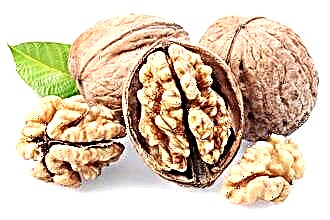Garlic is a bulbous plant that has a pronounced antimicrobial and antiphlogistic effect. The root vegetable contains biologically active substances that have a pronounced fungicidal, decongestant, immunostimulating and anti-inflammatory effect. Treatment of a cold with garlic helps to eliminate viscous mucus and purulent exudate from the paranasal sinuses, which speeds up the healing process.
 In informal medicine, the vegetable is used as an immunomodulator that increases the body's resistance.
In informal medicine, the vegetable is used as an immunomodulator that increases the body's resistance.
The active components contained in the juice stimulate the functioning of phagocytes, macrophages and killer cells.
Strengthening general immunity allows you to increase the body's resistance to colds.
Biochemical composition
Garlic in the nose is an effective way to eliminate the pathogenic flora in the nasopharyngeal mucosa. The pronounced therapeutic properties of the bulbous plant are due to the presence in its composition of a large number of macro- and microelements, vitamins and organic acids, which include:
- flavonoids;
- allicin;
- carotene;
- retinol;
- ascorbic acid;
- calciferol;
- tocopherol;
- niacin;
- lactoflavin;
- pyridoxine;
- folate;
- thiamine;
- copper;
- selenium;
- manganese.
Garlic juice contains all the B vitamins, except for cyanocobalamin (B12). The presence of allicin and flavonoids in the vegetable provides it with pronounced antioxidant and antimicrobial properties. For this reason, garlic is considered one of the most effective natural antibiotic remedies.
The product contains local irritating substances. Therefore, it should not be used to treat rhinitis in the presence of mechanical damage to the mucosa.
Operating principle
Using garlic for a runny nose, you can eliminate mucous secretions and facilitate nasal breathing within a few days. Root juice enhances the secretory function of the ciliated epithelium, due to which pathogenic mucus containing pathogens is evacuated from the nasal passages. The components of the agent promote the activation of T-lymphocytes, granulocytes and protective cells, which leads to the elimination of pathogenic flora from the nasopharynx.
In the course of medical research, it has been proven that the active substances contained in root crops are able to bind to protein structures on the surface of nerve cells. Due to this, the blood vessels in the nasal mucosa expand, as a result of which the microcirculation of blood in the ENT organs is normalized. Intensive oxygen supply to tissues accelerates their epithelization, which leads to an increase in local immunity.
Burying garlic in the nose from a runny nose, it is possible to eliminate local manifestations of a bacterial infection in just a few days. The competent use of an antiseptic agent speeds up the healing process and increases tissue reactivity. To prevent relapses of the disease, experts recommend using garlic juice for prophylactic purposes for another two weeks after complete recovery.
Pharmacological properties
 The timely use of the bulbous plant for therapeutic purposes contributes to the comprehensive healing of the body. A natural antiseptic removes free radicals and toxic substances from the body, which accelerates the detoxification process and reduces swelling in the mucous membrane.
The timely use of the bulbous plant for therapeutic purposes contributes to the comprehensive healing of the body. A natural antiseptic removes free radicals and toxic substances from the body, which accelerates the detoxification process and reduces swelling in the mucous membrane.
Important! Garlic juice is ineffective in the treatment of rhinitis and ENT diseases caused by viruses.
The medicinal effect of the product is due to the following properties:
- fungicidal - prevents the development of fungal pathogens, thereby reducing the risk of mycotic rhinitis;
- antioxidant - increases the concentration of alkalis in the mucous membrane of the ENT organs, which create unfavorable conditions for the development of bacteria;
- antimicrobial - disrupts the reproductive activity of bacteria, due to a decrease in their number;
- anticoagulant - thins the blood, as a result of which blood circulation in the affected tissues is accelerated;
- immunostimulating - increases the body's resistance to the negative effects of opportunistic bacteria and fungi.
Spectrum of action
It should be noted that the composition of the bulbous plant includes components that are active against fungi and aerobic bacteria. The effectiveness of the drug in the treatment of viral ENT diseases has not been proven. For this reason, experts do not recommend using garlic to treat viral rhinitis.
It is advisable to use a natural antibiotic for prolonged rhinitis and sinusitis, the development of which is due to the addition of a bacterial infection to a cold. The obvious signs of developing bacterial rhinitis are:
- strong rise in temperature;
- impurities of purulent exudate in mucus;
- prolonged inflammation of the nasopharynx (more than 7 days);
- difficult evacuation of viscous secretions from the nasal passages;
- yellow or green nasal discharge.
 For accurate confirmation of the diagnosis, it is advisable to be examined by an otolaryngologist.
For accurate confirmation of the diagnosis, it is advisable to be examined by an otolaryngologist.
The above signs are symptoms of the development of bacterial sinusitis, the untimely treatment of which can cause serious complications.
The uncontrolled spread of infection in the ENT organs leads to inflammation of the eye sockets, the Eustachian tube and even the brain.
Antibacterial drops
Garlic juice nasal drops can help relieve symptoms almost immediately. After 2-3 procedures, nasal breathing is facilitated, swelling of the mucous membrane and headaches are reduced. To prepare an antimicrobial solution, you can use the following recipes:
- using sterile gauze, squeeze the juice from 3 minced garlic cloves; instill 2 drops of garlic juice in each nostril at least 3 times a day;
- mix a small amount of garlic juice with sea buckthorn oil; instill 2-3 drops of warmed liquid daily into each of the nasal passages for a week;
- mix juice from 4 root vegetables with 200 ml of saline; instill 2 drops of the drug 3-4 times a day for 5 days.
Important! For the treatment of preschool children, freshly squeezed juice should be mixed with water in a ratio of 1:10.
Application of drops
The speed of elimination of symptoms of a bacterial rhinitis depends on the correct use of an antiseptic solution. In addition, a high concentration of active substances in the preparation can lead to burns in the mucous membrane. For this reason, during the preparation of nasal drops, the dosage recommended by phytotherapists must be strictly observed.
How should garlic nasal drops be instilled?
- cleanse the nasal passages of accumulated mucus and purulent discharge;
 rinse your nose with a mild sea salt solution;
rinse your nose with a mild sea salt solution;- drip 2 drops of the drug into each nostril;
- After 30 seconds, blow out any accumulated mucus from your nose.
During the procedure, a large amount of viscous secretion is formed in the nasopharynx, which must be removed from the sinuses and passages.
After cleansing the airways, experts do not recommend going outside, as this can lead to hypothermia and worsening health.
Oil drops
According to doctors, garlic with oil from the common cold promotes a softer cleansing of the mucous membrane from purulent secretions and viscous secretions. Vegetable oil neutralizes the action of components that irritate the mucous membranes.This reduces the risk of burns and allergic reactions.
To prepare oil drops, you must:
- chop 2 cloves of garlic;
- strain the juice from the garlic mass using gauze;
- mix 10 ml of vegetable oil with garlic juice;
- infuse the solution for 5 days in a dark and cool place.
By adding 3-4 drops of sea buckthorn oil to the liquid, you can provide the drug with antiviral effect.
Before use, the emulsion should be warmed to room temperature to prevent vasoconstriction in the nasopharyngeal mucosa. To relieve the symptoms of sinusitis, it is advisable to instill 3 drops of the drug in each nostril at least 4 times a day.
Pediatricians warn that oil drops should not be used to treat infants. Penetration of fluid into the Eustachian tube can lead to inflammation and the development of aseptic otitis media.
Anti-cold ointment
It is possible to eliminate congestion only if the edema in the ciliated epithelium decreases. To do this, it is necessary to ensure the outflow of intercellular fluid from the affected tissues, which is possible in the case of accelerated blood microcirculation.  You can achieve the desired therapeutic results with an ointment that contains garlic juice.
You can achieve the desired therapeutic results with an ointment that contains garlic juice.
To prepare the ointment, it is necessary to mix the following ingredients in equal proportions:
- garlic juice;
- alpine violet root;
- aloe vera leaf;
- Vishnevsky ointment".
Soak cotton swabs in the prepared mixture and place them in the nasal passages for 20-30 minutes. To speed up the evacuation of mucus from the sinuses, lubricate the wings of the nose, the bridge of the nose and the area of the maxillary sinuses with ointment. The procedure must be performed at least three times a day until the state of health improves.

 rinse your nose with a mild sea salt solution;
rinse your nose with a mild sea salt solution;

